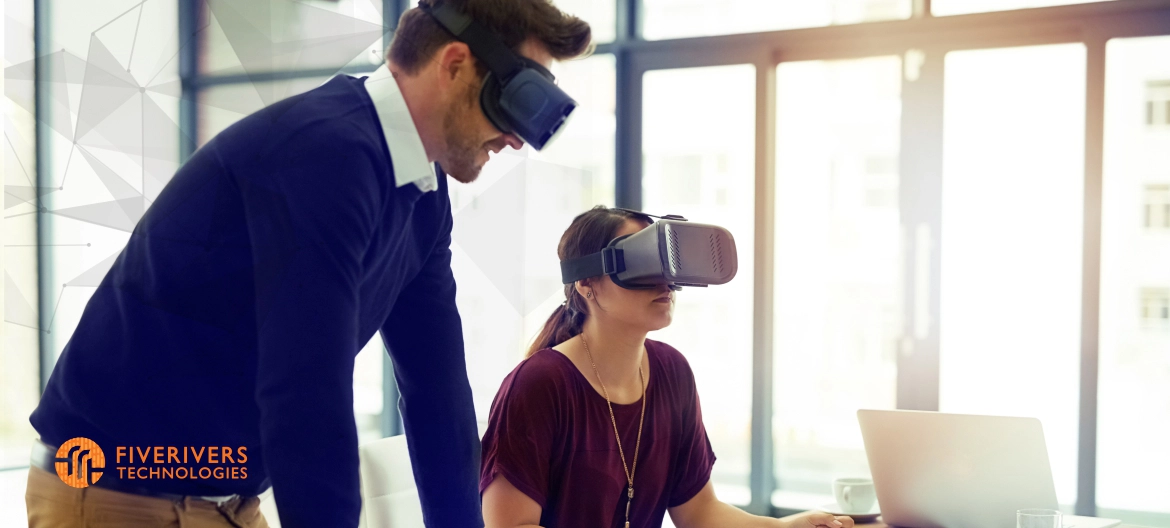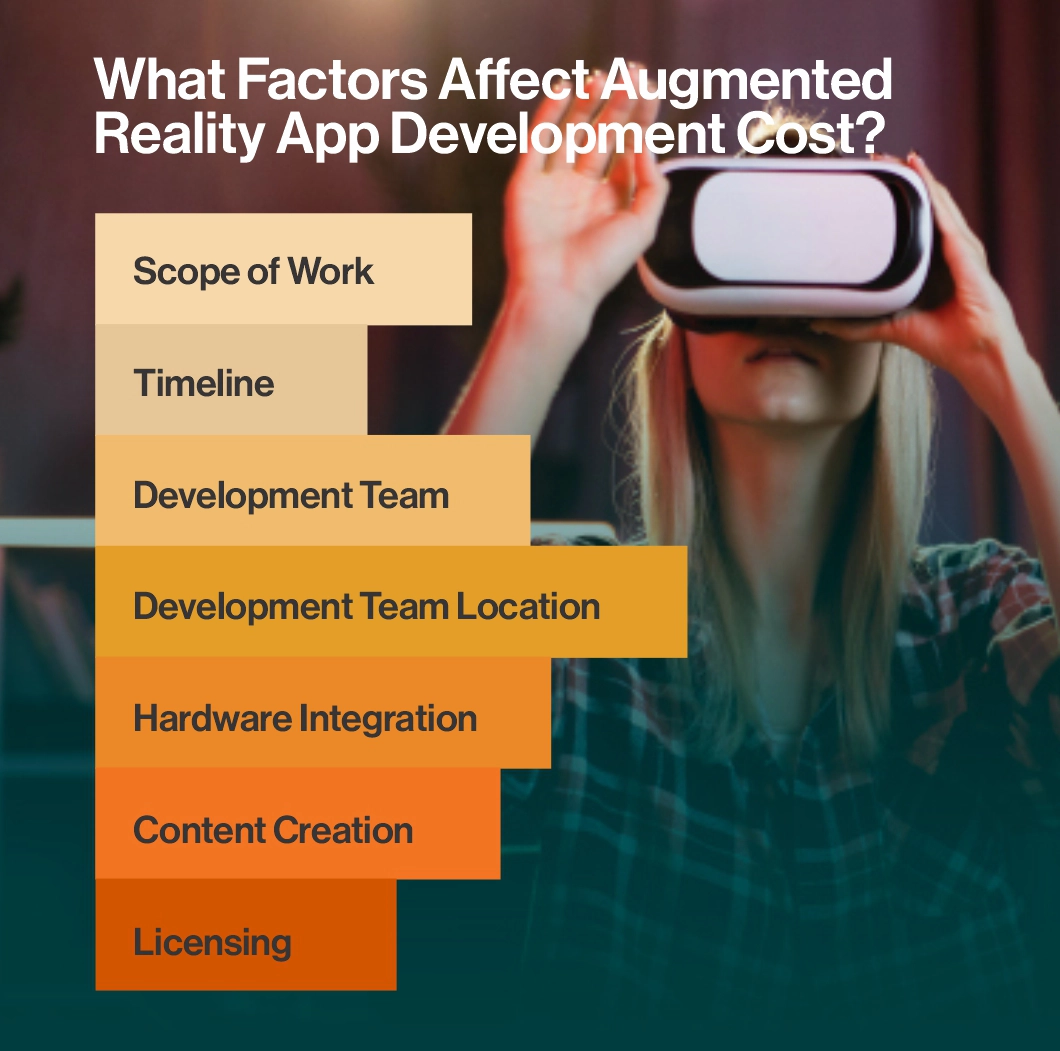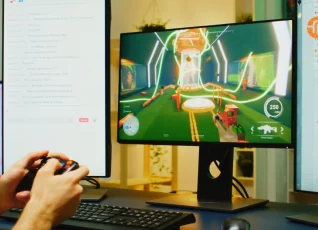As per Statista’s report, there will be 1.73 billion mobile augmented reality users by 2024, up from 0.44 billion in 2019. Therefore, creating an AR app is worthwhile. However, the cost of developing augmented reality apps is still a significant issue.
In this guide, we delve into the intricacies of AR app development costs, exploring key factors and providing insights to help navigate this exciting realm.
5 Best Augmented Reality Frameworks in 2024
How Much Does It Cost to Develop an Augmented Reality App?
As there is no set figure for AR app development, typically, it ranges from $5000 to $100,000 depending upon the feature and functionality of the app. Additionally, the cost will go up if a company wants to create an app with a custom algorithm and API.
If the project is outsourced, then region-wise cost also helps determine the project’s eventual cost.
Complexity-wise cost of AR App Development
A basic AR app might not cost a lot, but adding additional features can cause the cost to inflate. Here’s a table that can help explain specific AR app types and their approximate app development cost.
| App Complexity | Average Cost |
|---|---|
| Simple AR App | $10,000 – $50,000 |
| Medium-sized AR App | $50,000 – $200,000 |
| Complex AR Applications | $250,000 – $800,000 |
Region-wise Cost of AR App Development
Region also plays a significant role in determining the costs of AR app development, especially if the team is hired remotely.
| Region | ACost ($/hour) |
|---|---|
| North America | $60 – $275 |
| Australia | $55 – $150 |
| UK | $35 – $170 |
| South America | $45 – $150 |
| Central Europe | $22-$160 |
| India | $10 – $120 |
| Pakistan | $40 – $120 |
What Factors Affect Augmented Reality App Development Cost?
In addition to app complexity and region-wise cost differences, there are a few other factors that can affect augmented reality app development costs.
Scope of Work
The complexity and features of the AR app significantly impact its development cost. Basic AR apps with simple functionalities will cost less compared to apps with advanced features like 3D object recognition, real-time tracking, multiplayer capabilities, or integration with complex backend systems.
Timeline
The development timeline also affects the cost. Hastily planned initiatives might necessitate more resources or overtime from developers, which could raise expenses. On the other hand, a longer schedule might help spread out expenditures, but it can also mean higher project management and maintenance costs.
Development Team
The cost of AR apps is mostly determined by the expertise and skill level of the development team. Hiring a team with expertise in AR development, computer vision, 3D modeling, and app design will typically result in higher upfront costs but may lead to a better-quality product and potentially lower long-term maintenance costs.
Development Team Location
Costs may differ based on the development team’s location due to differences in labor and expenses. For example, hiring a team from regions with development costs may reduce development expenses compared to teams located in areas with higher living standards and wages, such as North America. When outsourcing development, it’s crucial to take things like time zone variations, communication problems, and language obstacles into account.
Hardware Integration
If the app needs to be compatible with specific AR hardware devices like HoloLens or Magic Leap, additional development and testing efforts may be required, leading to higher costs.
Content Creation
Developing 3D models, animations, and interactive elements for the AR experience can incur additional costs, especially if you require custom content tailored to your app’s unique requirements.
Licensing
If your app relies on third-party libraries, frameworks, or proprietary technologies, licensing fees or royalties may apply, increasing overall development costs.
What is The Formula to Calculate AR Development Cost?
To guarantee they receive the best product, organizations must budget their money. In the case of developing an AR app, naturally, the first thing is to calculate the development costs. Following is the formula used to calculate Augmented reality development costs:
Time Required to Develop an AR App*Hourly Development Cost = Total AR Development Cost
Let’s understand this formula.
The first variable is the time required to develop an AR app. Let’s say it takes 200 hours to develop an AR app. So, multiply this number with the hourly development rate, let’s say, $60.
Hence, the amount you must pay comes out to be – 200 Hours *$60/hour = $12,000.
How Does Augmented Reality Works?
When using a device like a smartphone, tablet, or AR glasses, users may view digital material like photographs, movies, or 3D models overlaid on the actual world. This is known as augmented reality (AR).
AR devices employ a variety of sensors, including gyroscopes, accelerometers, GPS, and cameras, to comprehend the user’s environment. These sensors collect information on the user’s position, orientation, and the surrounding objects in the actual world.
The data collected by sensors is processed, examined, and interpreted by the AR. This stage entails locating surfaces, items, and other pertinent environmental elements.
The AR software receives data from sensors and processes it, interpreting and analyzing the data. In this stage, surfaces, objects, and other pertinent environmental elements must be identified.
The program superimposes digital material on top of the user’s real-world vision after understanding the surroundings. Any type of digital information is acceptable, including text, photos, animations, and 3D models. The material is dynamically displayed to conform to both the user’s viewpoint and the surrounding environment.
The final step is displaying the augmented view to the user. This can be done through the device’s screen (in the case of smartphones and tablets) or through AR glasses, which project the augmented content directly into the user’s field of view.
Types of Augmented Reality Apps
There are five types of augmented reality apps, each varies in terms of functionality and complexity.
Projection-Based AR
Projecting virtual images onto actual physical surfaces is the method used in this kind of augmented reality app. It frequently calls for specialized tools like sensors and projectors. Projection-based AR can create immersive experiences, especially in large-scale installations or events.
Marker-Based AR
Marker-based AR apps overlay virtual material using predefined markers as points of reference, such QR codes or certain photos. Digital components are superimposed over these marks by the device’s camera when it recognizes them. Apps for gaming, education, and advertising frequently employ this kind.
Marker less AR
Marker-less AR, sometimes referred to as location-based AR, is independent of predetermined markers. Rather, it makes use of the device’s sensors, including the gyroscope, accelerometer, and GPS, to ascertain the user’s position and location. Applications for health, travel guides, and navigation frequently employ this kind of augmented reality.
Location-based AR
Using the user’s geolocation, this kind of augmented reality app superimposes digital material over the actual world. The device’s camera and GPS data are integrated to deliver contextually relevant information.
Superimposition AR
AR superimposition is the process of superimposing virtual items on top of the scene as seen by the device’s camera. Users can engage with virtual aspects in real time because of its seamless integration of digital material with the actual world. Virtual try-on experiences, interior design, and gaming are three industries that frequently employ this kind of AR.
What Are the Benefits of Augmented Reality App Development?
Developing AR apps can help businesses leverage several benefits. Some of them are:
Creates Unique User Experiences
Users of AR apps may have engaged, immersive experiences that combine the virtual and physical worlds. By overlaying virtual objects or information onto the user’s surroundings, AR apps can create novel and engaging experiences that capture users’ attention and imagination.
Increases Work Efficiency
AR apps may increase productivity across a range of industries, including manufacturing, maintenance, and healthcare, by giving employees real-time information, instructions, and assistance superimposed on their physical surroundings. Processes can be streamlined to decrease mistakes and increase productivity.
Removes Cognitive Overload
AR apps can simplify complex tasks by providing contextual information directly within the user’s field of view. By reducing the need to switch between different tools or reference materials, AR apps can help users focus on the task at hand and make faster, more informed decisions.
Fosters Interactive Marketing
AR apps give companies new and creative ways to interact with customers and build brand recognition. AR applications may improve marketing efforts and generate unique brand experiences by allowing customers to engage with virtual objects, try out virtual activities, or access supplementary material through their mobile devices.
Which Industries Could Benefit from Augmented Reality Apps?
Manufacturing Industry
AR has applications in manufacturing for maintenance, quality assurance, and assembly. Employees can carry out activities more correctly and effectively by using augmented reality (AR) glasses or gadgets to superimpose digital instructions or blueprints onto machines. AR may help with onboarding training by offering simulations and step-by-step instructions.
Education Industry
AR can significantly change the way students learn through captivating and immersive experiences. AR apps, for instance, may superimpose extra content, such as historical details or 3D models, over textbooks or other educational resources. Through visualization, this technology can improve student understanding of difficult subjects and make learning more enjoyable.
More importantly, AR in the education industry is scaling at a great pace. According to market research, augmented reality in the education market is expected to reach a CAGR of 32% and hit a valuation of $55.84 billion in 2033.
Healthcare Industry
AR has numerous applications in healthcare, including medical training, surgical planning, and patient education. During surgeries, surgeons may view the anatomy of their patients via AR, increasing accuracy and lowering risks. AR apps can also assist healthcare professionals in training scenarios, such as practicing surgical techniques or diagnosing medical conditions through interactive simulations.
Also, according to Allied Market Research, the global AR in healthcare industry is projected to reach $4237.60 billion by 2026.
Fashion Industry
Customers may virtually try on apparel and accessories with augmented reality. Retailers may create augmented reality applications that let consumers utilize AR-enabled mirrors or their smartphone cameras to view how clothes appear on them in real time. Customers may use this technology to make better-informed purchases and lessen the requirement for actual changing rooms.
Final Word
The intricacy and team location impact the cost of developing an augmented reality app. A comprehensive grasp of these facets is necessary to make informed decisions. Even with their complexity, augmented reality apps have a lot to offer, from bettering user experiences to increasing productivity.
Organizations may fully use AR technology by skillfully navigating the development process and collaborating with seasoned teams while considering these factors.
FAQs
How Much Does It Cost to Develop AR Apps?
A basic augmented reality app takes between $5000 and $45000 to build. But the price of a medium-sized or complex augmented reality app can reach $200,00 and $750,000, respectively.
How Much Time Does It Take to Develop a Basic AR App?
Developing an AR app depends on factors such as app features, complexity, and development costs across regions. However, it typically takes 100–150 hours to develop a basic augmented reality app.









